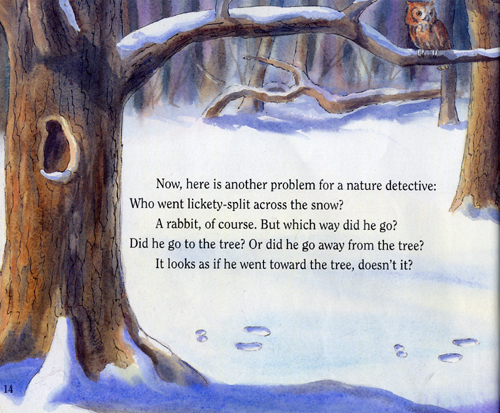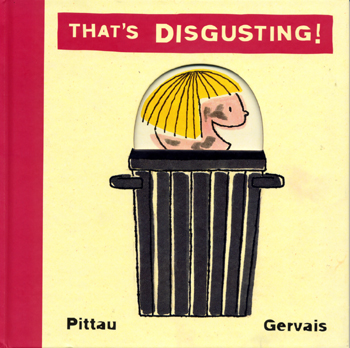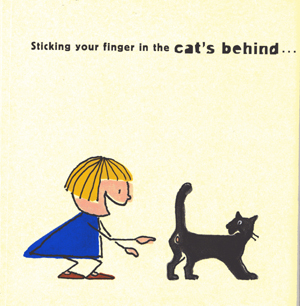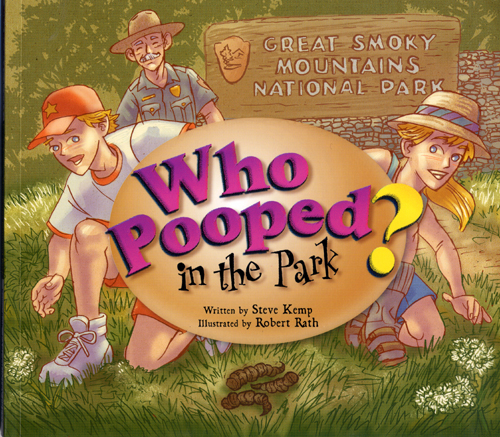Dr. Free-Ride: Hey, can you get your slime lizard [a plastic lizard embedded in slimy goo] off the table before dinner?
Elder offspring: Sure.
Dr. Free-Ride: Why do you two like gross stuff so much?
Younger offspring: I don’t know.
Elder offspring: We just do.
The sprogs like learning. And, the sprogs like things that are gross. Today, they offer a selection of books to show how the icky can enhance the informational.
Informational but not icky: Big Tracks, Little Tracks: Following Animal Prints by Millicent E. Selsam, illustrated by Marlene Hill Donnelly.

This book helps kids to become “nature detectives” by getting them to look at different kinds of animal tracks for clues about the animals that left them. The presentation is pretty Socratic: What do we see in the prints? What do we know about how this animal or that animal moves about? For instance, these pages on rabbit tracks and what they tell us about the direction the rabbit was traveling:


The approach of inferring what happened from clues is fun. There are some facts that are kind of cool to learn (e.g., seagulls run into the wind to take off, so you can tell by the direction of their footprints what direction the wind was blowing when they launched). But the ick factor for this book is pretty low. (There is a transgressive moment where cats and dogs switch places, but it’s not gross.)
Learning will happen, but in this case it won’t be accompanied by uproarious laughter.
Icky but not especially informational: That’s Disgusting! by Francesco Pittau and Bernadette Gervais.

This is a fairly straightforward picture-book that sets the sprogs to giggling. It uses the time-honored literary device of the refrain (“That’s disgusting!”) every other page. And, it runs through a litany of vividly illustrated events which disgust. Rolling in the mud? Check. Finding a hair in your ice cream? Got it. Drinking your bath water? Oh yeah, it’s here.
One of the things that becomes pretty clear to the adult reading the book, however, is how our judgments about what’s disgusting are culturally influenced. Is letting slugs crawl down your arms objectively disgusting, or is it something we learn to be disgusted by (or not to be disgusted by)? Smelling a sock might be a good way to get information (Does it need washing? Has the person wearing it been eating garlic?), and might indeed be good training for being able to handle other challenging smells later (say, in an organic chemistry lab).

This means that this is a book that can open discussions with young’uns about why we find certain things yucky. Indeed, certain of the contents provide teachable moments not only about germs and parasites and various routes of transmission of same, but also about respect for the bodily autonomy of other creatures. And you can absolutely have these conversations with giggling children. For some of them, though, you might need to do a bit of your own research first.
Belly-laughs galore, but the real information depends on an older reader engaging the kids in conversation about the gross-out.
Icky and informational: Who Pooped in the Park? Great Smoky Mountains National Park by Steve Kemp, illustrated by Robert Rath.

Like Big Tracks, Little Tracks, this book gets kids interested in the inferences they can draw from their observations. However, it beats out Big Tracks, Little Tracks for the simple reason that poop (as a charter member of the Pantheon of Gross Things) is absolutely hilarious.
In fact, scat is only the bait that attracts kids (like flies, if you will) to learn about the other clues animals leave in the National Park: tracks, nibbled twigs and scraped tree bark, rocks that have been moved. This book doesn’t just talk about the particular animals that inhabit Great Smoky Mountains National Park, but it describes some of the ways they interact with each other in the ecosystem. (For example, the non-native wild hogs eat up the native salamanders.) Scattered through the book are “The Straight Poop” boxes of related facts (e.g., that rabbits eat their own scat to maximize the nutrition they get out of their food by digesting it twice).
The sprogs love this book. And, now on hikes they always have something intelligent to say about animal droppings we may come upon — at least, once they’re done giggling.
There are versions of this book available for many other National Parks, each of which deals with the particular fauna that inhabits (and poops in) the particular park.

Thanks for this.
You know what? I think this post answers the question you posed yesterday: This is an effective way to talk to people who happen to be nonscientists.
This integrates science into what a lot of people might call real life.
This reflects an authentic human experience that scientists share with nonscientists.
This demonstrates a life that includes science, rather than a life that is separated by science.
For all those reasons, this a valuable contribution. So…thanks!
—
On of the guys here in Helsinki did his PhD on cattle dung beetle communities. So, when he wanted lots of samples, he contacted a youth organisation, and asked them to arrange for their members to send him samples (he gave instructions, of course). Fun, educational, and good science!
Bob
Sadly, as I was reading the post, I was hoping you’d get to scat…and there it is! I think I’ll pick up one of those books for my kiddos as well.
LOL at Tara saying “sadly”.
I love the Let’s Read and Find Out series. We have Animals in Winter and my almost 4-year-old can’t get enough of it.
The rule in our house is no carnivore/omnivore poop in the car….otherwise we’d come home with all kinds of stuff (vegetarian scat is so common around here the boys just kinda go ho hum.) But we always poke apart the bear and coyote scat to see what they’ve been eating. Sunflower seeds in bear scat a solid mile up and over a mountain from the nearest feeder was a great reminder of how far they’ll range for food.
A year or so ago my oldest boy (who is 7 years older than the next in line) watched his little brothers happily dissecting various pieces of cows and sheep and pigs then turned to me and said “That’s why they call it gross anatomy.”
Currently the 7yo is totally into leeches. Very very happy when he found a pregnant leech who has now become a mom.
I LIKE POOP! I LIKE POOP! I LIKE POOP!
I LIKE POOP! I LIKE POOP! I LIKE POOP!
I LIKE POOP! I LIKE POOP! I LIKE POOP!
I LIKE POOP! I LIKE POOP! I LIKE POOP!
[Kathy reiterated this message for another 130 lines. Suffice it to say, she likes poop. — JDS]